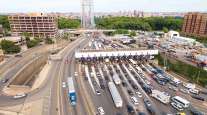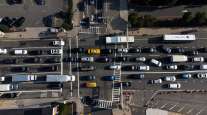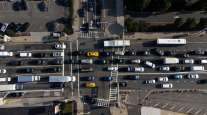Senior Reporter
Chicago Tops Latest Bottlenecks List

WASHINGTON — For the second time in as many weeks, a study has identified the worst traffic choke points, amplifying the nation’s urgent need for investment in its transportation infrastructure.
The most recent report, from the American Highway Users Alliance, focused on the worst car and truck bottlenecks.
Chicago led the way by having the most congested interchange: Kennedy Expressway (Interstate 90) between the Circle Interchange (I-290) and Edens Junction (I-94).
The report followed another released by the American Transportation Research Institute that identified truck-specific bottlenecks. Atlanta came out on top in that study for its five-level stack interchange known as “Spaghetti Junction,” which joins I-285 and I-85 north. Chicago ranked second in the ATRI study.
Both studies suggested that congestion was getting worse each year and average speeds were slowing at peak and off-peak times.
The American Highway Users Alliance report examines the top 30 choke points and offers possible solutions.
“There are many more bottlenecks across the country, and we have a list of congestion zones all around the country,” Alliance President Greg Cohen said at a Nov. 23 news conference.
Bill Graves, president of American Trucking Associations and chairman of the American Highway Users Alliance, said the study underscores the need for Congress to pass a long-term highway bill.
“Our highways are the circulatory system carrying the commerce that’s the lifeblood of this nation’s economy,” Graves said. “When we hit bottlenecks, it’s unhealthy for America for a variety of reasons.”
Graves said truck travel is expected to increase at a rate twice that of passenger vehicles over the next 20 years.
“So the question is whether we’ll be handling these loads on the same old aging roads and bridges,” he added.
Cohen said that, in addition to improving mobility and quality of life for motorists, fixing the top 30 bottlenecks alone over the next 20 years would save $39 billion in lost time and 830 million gallons of fuel, would reduce greenhouse-gas emissions by more than 17 billion pounds and would prevent 211,000 vehicle crashes.
The American Highway Users Alliance list of bottlenecks includes trouble spots in metropolitan areas: 12 in Los Angeles, nine in and around New York City, three in Chicago, three near Washington, D.C., three in Houston, three in Boston, three in Dallas, three in Miami, two in Atlanta, two in Philadelphia, and two in the San Francisco-Oakland area.
Chicago’s I¬90 is a 12¬mile bottleneck that cost motorists 16.9 million hours of waiting in traffic and wasted more than 6.3 million gallons of fuel while cars idled or crawled, according to the alliance.
Transportation Secretary Anthony Foxx, speaking at the news conference, called the new reports “very timely” as Americans traveling for the holidays figure out their strategies to avoid traffic.
“Road¬dependent communities in America are going to need multimodal solutions,” Foxx said. “And this Thanksgiving, what America is getting is a preview of what we can expect to occur over the next 30 years if things go unchecked — a nation consumed by traffic and Thanksgiving traffic every day in some places around the country.”
Foxx urged Congress to pass a long-term highway bill by Dec. 4. Pat Thomas, senior vice president of state government affairs for UPS Inc. and ATA’s chairman, said congestion is a huge drag on the economy and risks making American businesses less competitive globally.
“For every five minutes one of our drivers is held up in congestion, there’s an economic impact of $105 million a year,” said Thomas, who also spoke at the news conference. “To calibrate that into the rest of the industry, that’s more than $9 billion a year in wasted productivity and cost on congested roads across this country.”




